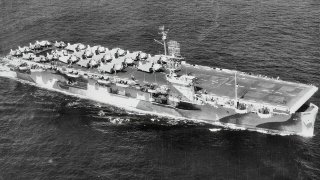The U.S. Navy Built An Amazing 50 Casablanca-Class Escort Aircraft Carriers
The Casablanca-class escort carriers were crucial to the Allied victory in World War II. Built rapidly by the Kaiser Shipbuilding Company, these aircraft carriers were designed to escort convoys and support amphibious operations.
Summary: The Casablanca-class escort carriers were crucial to the Allied victory in World War II. Built rapidly by the Kaiser Shipbuilding Company, these carriers were designed to escort convoys and support amphibious operations.
Key Points:
-Though slower and smaller than fleet carriers, they played a vital role in resupplying forces and defending against enemy threats.
-The U.S. Navy lost five Casablanca-class carriers during the war. Despite their limitations, these carriers demonstrated remarkable engineering and significantly contributed to the Allied war effort.
Casablanca-Class Escort Carriers: Unsung Heroes of WWII
Japan’s decision to attack Pearl Harbor is likely what led the Allies toward victory. Although the U.S. military suffered heavy losses in the initial months of World War Two, the industrial might of America flooded the Allied arsenal with weapons.
One of the big problems the Allies faced was how to resupply their forces. Airlift was not a reliable option at the time, so the majority of resupply had to take place at sea. German, Italian, and Japanese submarines, battleships, and aircraft presented a combined threat that cost the lives of tens of thousands of Allied sailors.
A radical proposal was put on the table. The Kaiser Shipbuilding Company offered to build 50 escort carriers in less than two years. That included laying down, launching, and commissioning the ships, a rather monumental effort in wartime.
Although skeptical at first, the U.S. Navy agreed due to heavy losses in the early stages of the war. And so the Casablanca-class escort carriers came to be.
As their name suggests, these carriers were designed to escort convoys rather than directly challenge larger enemy forces.
The escort carriers were slower than fleet carriers and could reach speeds of approximately 19 knots (or 22 miles per hour). They required a crew of around 850, plus the pilots and maintainers of the embarked air squadrons.
Casablanca escort carriers could carry about 27 fighter jets. In comparison, Midway-class fleet carriers could carry up to 130 fighter jets, while Essex-class fleet carriers could carry up to 100. But these larger vessels were designed to take out enemy carrier battlegroups and battleships, whereas Casablanca-class carriers were designed to accompany and protect convoys, support amphibious operations, and generally free fleet carriers to do their job.
Casablanca-class escort carriers could field a combination of aircraft including F4F Wildcat fighter jets and Grumman TBF Avenger torpedo bombers. For self-defense, the carriers packed a 5-inch (127mm) gun, eight 40mm Bofors anti-aircraft guns, and twelve 20mm Oerlikon anti-aircraft guns. Depending on the mission and the threat level in the area, the escort carriers could carry additional air-defense weapons systems.
In total, the Navy lost 11 aircraft carriers during World War Two. Five of them were Casablanca-class flattops. Three were sunk by Kamikaze attacks, one by submarine, and one by naval fire. An additional escort carrier was heavily damaged by a Kamikaze attack but was repaired.
With 50 flattops built, the Casablanca class is the largest class of carriers in history.
Several carriers of the Casablanca class remained in the Navy’s active fleet after the conflict ended and went on to serve for several years, including during the Korean War.
Almost 80 years after the end of World War Two, the Casablanca-class escort carriers remain a marvel of engineering.
About the Author:
Stavros Atlamazoglou is a seasoned defense journalist specializing in special operations and a Hellenic Army veteran (national service with the 575th Marine Battalion and Army HQ). He holds a BA from the Johns Hopkins University and an MA from the Johns Hopkins’ School of Advanced International Studies (SAIS). His work has been featured in Business Insider, Sandboxx, and SOFREP.


